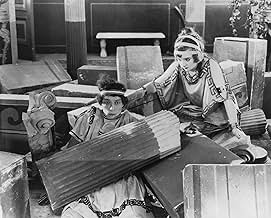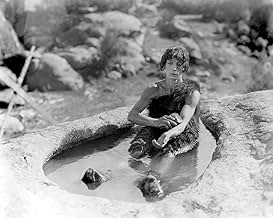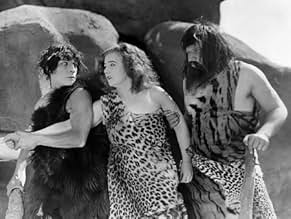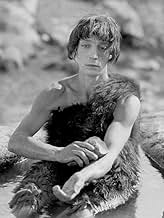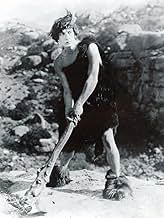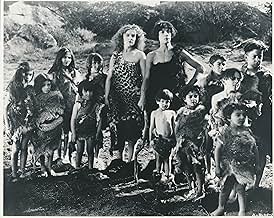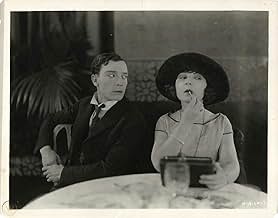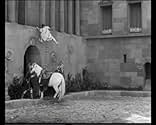AVALIAÇÃO DA IMDb
7,0/10
5,6 mil
SUA AVALIAÇÃO
Adicionar um enredo no seu idiomaThe misadventures of Buster in three separate historical periods.The misadventures of Buster in three separate historical periods.The misadventures of Buster in three separate historical periods.
- Direção
- Roteiristas
- Artistas
- Prêmios
- 1 indicação no total
Kewpie Morgan
- The Emperor
- (as Horace Morgan)
- …
Lionel Belmore
- Undetermined Role
- (não confirmado)
- (não creditado)
Bernard Berger
- Roman-age child
- (não creditado)
Basil Bookasta
- Stone Age Child
- (não creditado)
George Bookasta
- Stone Age Child
- (não creditado)
George Davis
- Roman Guard Knocked Down
- (não creditado)
Louise Emmons
- Old Fortune Teller
- (não creditado)
F.F. Guenste
- Butler
- (não creditado)
Blanche Payson
- The Amazon
- (não creditado)
Avaliações em destaque
Although the movie is clearly dated, audiences can still easily identify with the plight of hapless Buster in this timeless and very funny underdog tale. Buster fights against unkindly odds in three different ages: the Stone Age, The Roman Age, and the Moden Age, playing almost the same character with just a change of scenery to help us identify the different "ages". In this movie we see one of the earliest comedic depictions of the "caveman" stereotype, who wins his love not by romance but by brute force, as well as a funny twist on Roman gladiatorial combat, two comedic sketches that long predate such spoofs as Mel Brooks' "History of the World: Part I". The underlying theme of the movie is simple yet convincing: Although the times may have-a-changed, we still face the same struggles even in modern times that we fought in prehistoric times in order to "win the girl" (keep in mind this is the theme of 1923 America, a time when chauvinism was still en vogue). It is interesting to look at this movie over eighty years later, and consider how dramatically things have changed from this movie's "modern times" to now.
First time of seeing Buster Keaton's first feature film and I have to admit I liked it a lot and only wish I'd stumbled across it years ago. The Rohauer blurb at the start warns that the Three Ages single nitrate print was rediscovered and salvaged in 1954 just in time before combustion, and many frames that seemed hopelessly glued together were separated. So, it's rocky viewing in places, but I've seen and survived much worse.
It would have been OK as the 3 short films but as a take on Intolerance it's inventive and funny from the start to the finish: In the Stone Age with baddie Wallace Beery riding an elephant and goodie Buster riding a pet brontosaurus; In the Roman Age Buster riding a chariot with wheel locks and adapted for sledging, No Parking signs in Latin; In this technological Age of Speed Need and Greed his car beautifully falls to bits at the first hump. Both him and Beery are after the Girl through the ages, a never ending tussle. Favourite bit: As the caveman he gets knocked backward over a cliff edge but still blows a kiss to the camera - an amazing second or two!
Great stuff, reaffirming my love of silent film comedy.
It would have been OK as the 3 short films but as a take on Intolerance it's inventive and funny from the start to the finish: In the Stone Age with baddie Wallace Beery riding an elephant and goodie Buster riding a pet brontosaurus; In the Roman Age Buster riding a chariot with wheel locks and adapted for sledging, No Parking signs in Latin; In this technological Age of Speed Need and Greed his car beautifully falls to bits at the first hump. Both him and Beery are after the Girl through the ages, a never ending tussle. Favourite bit: As the caveman he gets knocked backward over a cliff edge but still blows a kiss to the camera - an amazing second or two!
Great stuff, reaffirming my love of silent film comedy.
For me, Keaton's decision to make a parody of Griffith's Intolerance so that if the feature (his first) failed he could re-edit and release it as three two-reelers is what diminishes the enjoyment for me. The film jumps back and forth between the three time periods, and so all of them seem to be over before they've really begun, and the film has something of a disjointed feel. Perhaps this is because the film does actually feel as if it is three two-reelers spliced together rather than an actual feature.
The comedy is unevenly paced, but when it hits the mark it is near-perfect. Highlights include Keaton's drunken encounter with Wallace Beery, other diners, and a crab at a restaurant, and the jaw-dropping leap from one roof to another at what looks like hundreds of feet above the ground (apparently the buildings were short sets placed on a bridge overlooking a view of Los Angeles. Just as well, because Keaton failed to make the leap successfully and fell from the second building, a real-life mishap that remains in the film). Keaton slides through a window, across a room, down a pole (at this point we realise he is in a fire station although he doesn't) and lands on the back of a fire engine that returns him to the police station from which he has just escaped. The whole sequence is both side-splitting and astounding. The look on Keaton's face as he looks quizzically up at the pole he has just descended is priceless. Perhaps because of his status as a comic genius we tend to forget how good an actor Keaton was .
I liked the modern sequence best, and had it been released as a short I believe it would be considered one of his classics. The caveman sequence is OK, but the Roman era story tends to drag.
It's been well publicised that this was competition winner Margaret Leahy's only film because she was so untalented as an actress, and it's true she doesn't light any fires while on-screen. But the impact of her ineptitude in front of the camera is cleverly avoided by the likes of Keaton and Beery merely acting around her as if she were just another prop.
Overall, this isn't one of Keaton's best - although that is probably because this is his first feature. Keaton himself thought it was just OK and, given his instinctive sense for what works, perhaps that should tell us all we need to know...
The comedy is unevenly paced, but when it hits the mark it is near-perfect. Highlights include Keaton's drunken encounter with Wallace Beery, other diners, and a crab at a restaurant, and the jaw-dropping leap from one roof to another at what looks like hundreds of feet above the ground (apparently the buildings were short sets placed on a bridge overlooking a view of Los Angeles. Just as well, because Keaton failed to make the leap successfully and fell from the second building, a real-life mishap that remains in the film). Keaton slides through a window, across a room, down a pole (at this point we realise he is in a fire station although he doesn't) and lands on the back of a fire engine that returns him to the police station from which he has just escaped. The whole sequence is both side-splitting and astounding. The look on Keaton's face as he looks quizzically up at the pole he has just descended is priceless. Perhaps because of his status as a comic genius we tend to forget how good an actor Keaton was .
I liked the modern sequence best, and had it been released as a short I believe it would be considered one of his classics. The caveman sequence is OK, but the Roman era story tends to drag.
It's been well publicised that this was competition winner Margaret Leahy's only film because she was so untalented as an actress, and it's true she doesn't light any fires while on-screen. But the impact of her ineptitude in front of the camera is cleverly avoided by the likes of Keaton and Beery merely acting around her as if she were just another prop.
Overall, this isn't one of Keaton's best - although that is probably because this is his first feature. Keaton himself thought it was just OK and, given his instinctive sense for what works, perhaps that should tell us all we need to know...
Loosely intended as a satire of D.W. Griffith's Intolerance, The Three Ages was Buster Keaton's first attempt at a full length comedy feature. The only similarities to Intolerance are the opening "book" scene and the fact that similar stories through the ages are edited together into a complete film. Keaton's reasoning for appropriating this style was that if it didn't succeed as a feature film, it could be reduced to three two-reelers. Fortunately, The Three Ages succeeds brilliantly as a comedy and contains some of the funniest routines I've seen in any of Keaton's film. There is nothing unique or daring about the story lines. They are simple boy-meets-girl, boy-loses-girl, boy-gets-girl plots, but the period satires are riotous and set the standard for future works by Mel Brooks and all films of this genre. However, I don't believe that anyone has ever topped this comedy. No one can play the lovable goof like Keaton and the stunts in this film are some of his best. In addition, Wallace Beery's appearance as Keaton's rival adds to this film's appeal. Anyone who thinks that comedy from the 1920's cannot be appreciated by modern audiences needs to see this movie.
"The Three Ages," Buster Keaton's first feature-length film after a number of comedy shorts, is his parody of Griffith's "Intolerance." Keaton tells three parallel stories about the perils of romance, one set in the Stone Age, one during the Roman Empire, and one during the 20th century.
In the context of Keaton, I don't see "The Three Ages" given a lot of mention. This is a shame, since while it's not Keaton's finest work, it ranks with his funniest. In one scene, Buster falls into a pit with a lion. Afraid of getting eaten, he pampers the lion and gives it a manicure. What follows is one of the funniest visual gags I've ever seen.
In the context of Keaton, I don't see "The Three Ages" given a lot of mention. This is a shame, since while it's not Keaton's finest work, it ranks with his funniest. In one scene, Buster falls into a pit with a lion. Afraid of getting eaten, he pampers the lion and gives it a manicure. What follows is one of the funniest visual gags I've ever seen.
Você sabia?
- CuriosidadesThe most famous stunt in the movie was actually built around what went wrong with the original stunt. Buster Keaton intended to leap from a board projecting from one building onto the roof of another building, but he fell short, smashing into the brick wall and falling into a net off-screen. He was injured badly enough to be laid up for three days. However, when he saw the film (the camera operators were instructed to always keep filming, no matter what happened), he not only kept the mishap, he built on it, adding the fall through three awnings, the loose downspout that propels him into the firehouse and the slide down the fire pole.
- Erros de gravaçãoIn the medium shot of the Stone Age soothsayer scene, Buster's hands are resting together near the side of the turtle. But in the cut to a close-up, we see only a hand double's right hand, and it's directly in front of the turtle's mouth. (It's clearly a hand double, since Keaton was missing his right index finger tip.)
- Versões alternativasIn 1995, Film Preservation Associates copyrighted a version with an orchestral score; no details were specified on the print.
- ConexõesEdited into The Golden Age of Buster Keaton (1979)
Principais escolhas
Faça login para avaliar e ver a lista de recomendações personalizadas
- How long is Three Ages?Fornecido pela Alexa
Detalhes
- Data de lançamento
- País de origem
- Idioma
- Também conhecido como
- A Idade da Pedra
- Locações de filme
- Empresa de produção
- Consulte mais créditos da empresa na IMDbPro
Bilheteria
- Faturamento bruto mundial
- US$ 177
- Tempo de duração1 hora 3 minutos
- Cor
- Mixagem de som
- Proporção
- 1.33 : 1
Contribua para esta página
Sugerir uma alteração ou adicionar conteúdo ausente

Principal brecha
By what name was À Antiga e à Moderna (1923) officially released in India in English?
Responda
